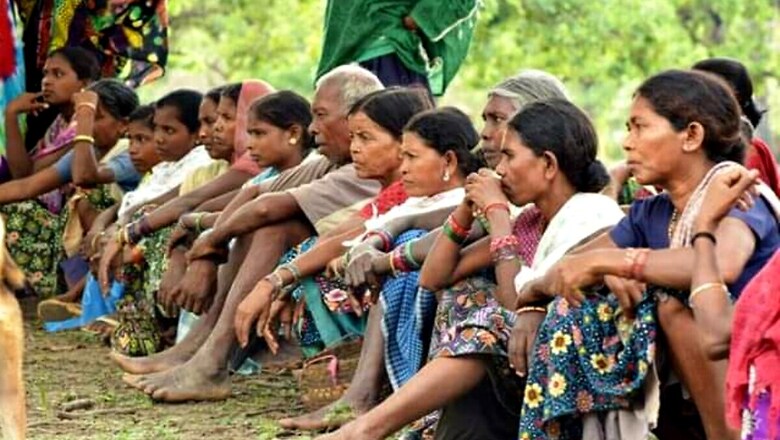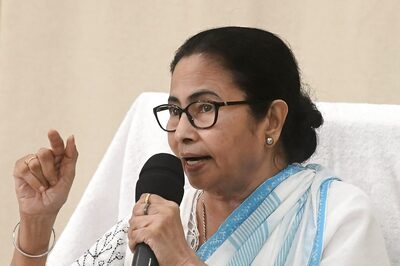
views
After Upendra Nath Biswas, popularly known as Upen Biswas, retired as additional director of the Central Bureau of Investigation (CBI) in 2002, he joined the Trinamool Congress and became an MLA from West Bengal’s Bagda assembly seat in Bangaon region, following which he actively started working for the empowerment of Scheduled Caste and Scheduled Tribe women.
Once in 2012, while travelling through a tribal village in Bagda, the former super cop noticed a half-broken rusted tin nameplate hanging in front of a dilapidated muddy house made of hay with a palm-frond roof; the nameplate had ‘Beauty Parlour’ incorrectly written on it as ‘Buty Parlor’, in Bangla.
Biswas became curious to know what the family members living in that ‘kutcha’ ramshackle house had to do with a beauty parlour, considering the backwardness of the area.
A few days later, after a community meeting with the tribal people, his wife, who was also present, said to him, “Upen, did you notice one thing? All the tribal women who attended the meeting came with proper make-up.”
“I said, ‘Is it?’ That day I got my answer on what that beauty parlour board was doing at the kutcha house of the tribal family. Further research and studies revealed that tribal women prefer ethnic beauty care with whatever limited resources they have at home. Then, I took up a project to empower SC and tribal women through beauty-care training,” Biswas told News18.
Since 2012, Biswas and his team (including renowned beauticians Shahnaz Husain and Flora Singh) have worked extensively and trained 27,800 SC, ST women selected from nearly 30,000 villages in Bengal in beauty care. “This was a record set in three and a half years and I named it ‘Ethnic Beauty Care’,” Biswas said.
While working on the project, Biswas, who is a cultural anthropologist besides being an expert in criminology, had a hidden mission to achieve — it was to break the caste and social barriers in rural Bengal.
“Usually, you will not find a beautician belonging to a lower caste. I mean their numbers are few. Also, among Santhali women, it is difficult to find anyone working and that too in the beauty-care industry. There is a general notion that beauty care is meant for upper caste people and my target was to bring these SCT, ST women of Bengal to this industry to break this notion.”
“Now you will ask me why I was so keen on this. The answer is, in Bengal, the SC population is nearly 23.51 per cent and the ST population is 5.85 per cent. So in total, the SC and ST population is nearly 30 per cent. A state cannot grow if you fail to bring 30 per cent of its population to the mainstream. And, I felt nothing could be better than a beauty-care training course for them because it is the fastest growing industry in the world. You won’t believe it, when we gave the advertisement of the course for the first time in 2012, the maximum response we received was from Jangalmahal,” Biswas said.
Coming back to his hidden mission behind starting the project, Biswas said he wanted to see whether upper-caste people were going to avail such services from SC, ST women. “We found, yes, this is happening. The first target was achieved because in rural Bengal you have limited options for beauty care. Willingly or unwillingly, people (mainly upper caste) will call them or visit them to get the best beauty care service. The ‘caste noose’ was broken with this mission. With this initiative, people started relating to each other with their professionalism and not with their castes and religions. So, here we make them trained into becoming a professional and secondly we manage to remove the caste albatross from around their neck,” he said.
“People used to laugh while saying, ‘Santhali women and beauticians?’ They used to question the efficiency of SC and ST women and that too in the beauty industry. Now that notion is not there. Also, we managed to give these women a ‘dignity platform’. Their status in society, in the house and in front of their husbands has improved. They started earning. We managed to improve their educational skills because here you have to learn the basics of English as names of beauty care products are written in English. The minimum eligibility criteria for the four-month course is higher secondary,” said Biswas.
The project has brought about a huge transformation among tribal and SC women in rural Bengal. The first phase of the project was started in 341 blocks with 25-60 training centres. In each batch there were 25-30 women. The first training centre came up in Haringhata in Nadia district.
While sharing the story of a tribal girl, Biswas said, “Being a cultural anthropologist, I have noticed a change in their personalities also. There is a tribal girl who used to change two buses and a van rickshaw to reach the training centre in Haringhata. Her name was ‘Pachi’ (a common tribal name). Once she completed the beauty-care course, her friends advised her to change her name from ‘Pachi’ to ‘Prachi’ as they felt ‘Prachi’ was a modern name and this could enhance her personality after the completion of the course. Now she is known as Prachi. She is running her own beauty parlour and earning Rs 14,000 to Rs 15,000 per month.”
“It’s a rebirth for me. I got a new identity with my skills and people started looking at me with respect. Now I am earning and I am very happy. I would like to thank Upen sir for giving this platform to several SC, ST women in Bengal,” Prachi said.
The second phase of the training is going on in all the districts. All the SC, ST women of the previous batch are well-settled: while some opened their own beauty parlours at their homes, others are working in private beauty-care companies.
“I am happy that I managed to break the status and caste barrier in rural Bengal through this beauty-care training,” said Biswas.
The 1968 batch IPS officer (West Bengal cadre), known as an anti-corruption crusader, first came in the limelight for pursuing former chief ministers of Bihar, Jagannath Mishra and Lalu Prasad Yadav, over their involvement in the Rs 950 crore fodder scam.
Read all the Latest News, Breaking News and Coronavirus News here




















Comments
0 comment